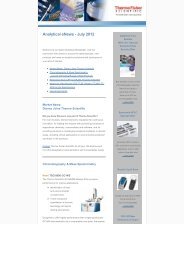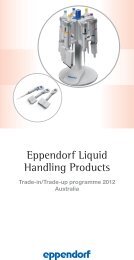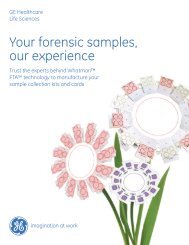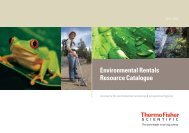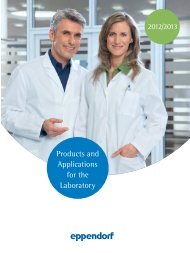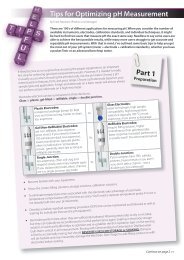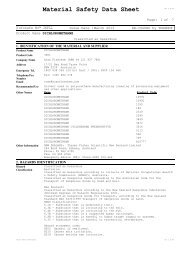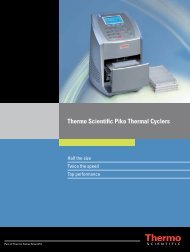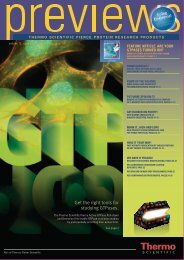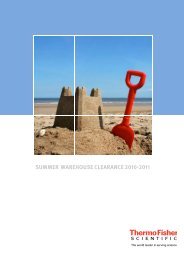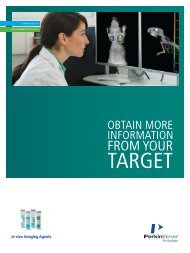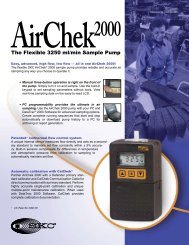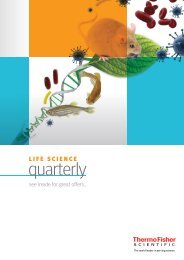Issue 1 - Thermo Fisher
Issue 1 - Thermo Fisher
Issue 1 - Thermo Fisher
You also want an ePaper? Increase the reach of your titles
YUMPU automatically turns print PDFs into web optimized ePapers that Google loves.
Clinical collaborations lead to patient therapies<br />
As one of the foremost scientists in the rheumatology<br />
field and the development of chondrogenic cultures from<br />
BMSCs, Professor Hollander works closely with clinical<br />
teams to develop patient-specific cartilage autografts.<br />
These are generated by extracting cartilage cells (rather<br />
than BMSCs) from the patient and culturing them to<br />
provide autologous chondrocytes, which are then seeded<br />
into a three- dimensional biodegradable material (derived<br />
from the total esterification of hyaluronan with benzyl<br />
alcohol and constructed into a non-woven configuration).<br />
These engineered grafts are then placed at the site of<br />
the cartilage injury, often without the need to glue or<br />
suture them in place. Furthermore, the procedure does<br />
not necessitate open surgery since a miniarthrotomy<br />
is usually sufficient. Once in place, the graft quickly<br />
integrates with the patient’s existing tissues, providing<br />
good collagen composition and integration with the<br />
underlying bone. The autograft technique provides<br />
several distinct advantages, namely less stressful surgical<br />
procedures and perhaps more importantly, the lack of<br />
any immune response. This is a major advance over<br />
allografts, which require the use of powerful immunesuppressing<br />
drugs for extended periods post-transplant.<br />
The first ever bio-engineered tracheal graft<br />
Last summer, Professor Hollander received a request<br />
for help from a friend and colleague, Professor Martin<br />
Birchall, a surgical professor at the University of Bristol.<br />
A patient of Dr Birchall’s had suffered serious damage to<br />
her trachea as a result of contracting tuberculosis (TB).<br />
The patient, was a young mother whose only chance<br />
of survival at the time was to have one lung removed,<br />
which would have seriously affected her quality of life<br />
and her ability to look after her children. After much<br />
discussion, Professor Hollander and his team very<br />
quickly set to work adapting their existing osteoarthritis<br />
based protocols to enable Professor Birchall to grow<br />
a large population of chondrocytes derived from the<br />
patient’s BMSCs. A section of human trachea was<br />
donated for use as a scaffold on which the new tissue<br />
could be grown. The trachea was stripped of the donor’s<br />
cells, leaving a trunk of non- immunogenic connective<br />
tissue onto which the chondrocytes were seeded. This<br />
seeding process used a novel bioreactor developed<br />
at the Politechnico di Milano, Italy, which provided the<br />
right environment for the cells to form the cartilaginous<br />
part of the trachea within four days of seeding. The graft<br />
was then lined with epithelial cells and transplanted<br />
into the patient, who responded very quickly to the<br />
new airway section, without any sign of rejection (no<br />
antibodies to the graft were found). Subsequent biopsies<br />
have shown that the new section is fully integrated<br />
with the existing airway and is fully supplied with blood<br />
vessels. She is now able to live life as if she had not<br />
been struck down with TB, a result that would never<br />
have been possible if her lung had been removed.<br />
Discussion<br />
Stem cell based-therapies have promised huge changes<br />
in the treatments of many diseases and disorders, but<br />
much research is still required to ensure safety and<br />
consistency before they can be applied more extensively.<br />
Prof Hollander and his colleagues at the Department<br />
of Cellular & Molecular Medicine at the University<br />
of Bristol have been investigating the fundamental<br />
principles governing the differentiation of bone marrow<br />
stem cells into chondrocytes – the source of cartilage.<br />
Through this research they aim to further improve<br />
the processes used to generate chondrocyte-based<br />
autografts, which have already started to prove their<br />
value in the treatment of cartilage damage. Throughout<br />
their pioneering research, Professor Hollander’s team<br />
has come to rely on the dependability and functionality<br />
of a broad array of standard and advanced laboratory<br />
equipment specifically designed to provide the highest<br />
quality and reliability in the cell biology laboratory. As<br />
a result of their dedicated work, Professor Hollander’s<br />
team was able to take part in the amazing feat of the<br />
first ever bio-engineered tracheal graft. Their work<br />
has enabled this patient to regain an amazing quality<br />
of life following a life-threatening condition while<br />
increasing the drive among researchers and clinicians<br />
to more expansive use of stem cell based therapies.<br />
Feature article<br />
Professor Anthony<br />
Hollander, ARC<br />
Professor of<br />
Rheumatology & Tissue<br />
Engineering in the<br />
Department of Cellular<br />
& Molecular Medicine<br />
at the University of<br />
Bristol, UK. (Image<br />
courtesy of Dr Sally<br />
Dickinson, University<br />
of Bristol).<br />
Figure 1. Adherent<br />
human adult bone<br />
marrow stem cells in<br />
culture. (Image courtesy<br />
of Dr Sally Dickinson,<br />
University of Bristol)<br />
Figure 2. Tissue<br />
engineered cartilage<br />
produced from<br />
bone marrow stem<br />
cells (Macroscopic<br />
Appearance). (Images<br />
courtesy of Dr Sally<br />
Dickinson, University<br />
of Bristol).<br />
21



